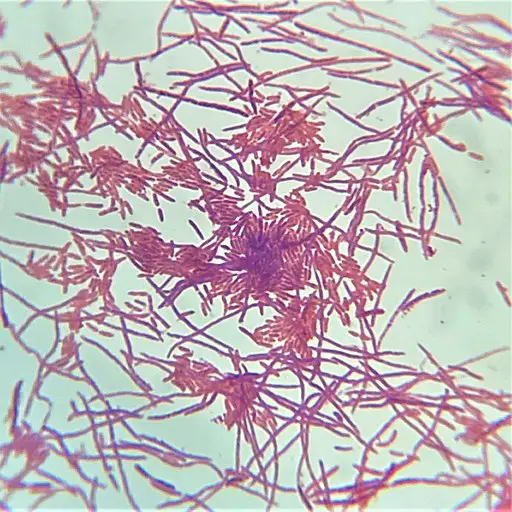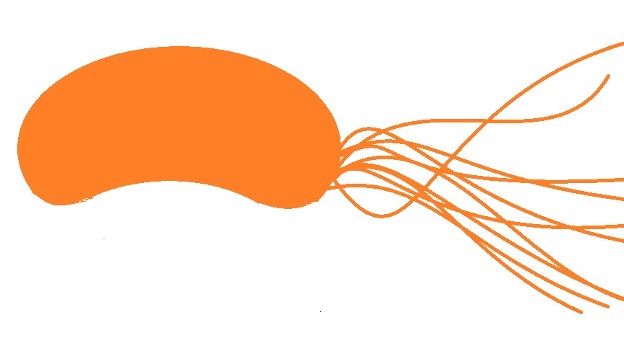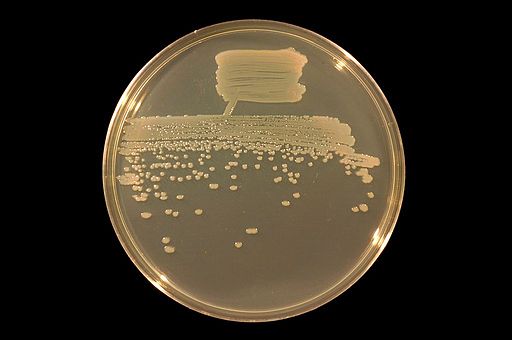Pseudomonas fluorescens
** Characteristics and Morphology
Overview
Pseudomonas fluorescens is a member of the genus Pseudomonas within the Class Gammaproteobacteria. As such, they are Gram-negative bacteria with a rod-shaped morphology. It can be found in various habitats in terrestrial and aquatic environments as a free-living organism.
Though it's not generally considered a human pathogen, it is pathogenic to a number of aquatic animals and some birds. On the other hand, it's beneficial in agriculture and has been used to protect crops from a number of other harmful organisms.
General classification of Pseudomonas fluorescens:
Domain: Bacteria
Phylum: Proteobacteria/Pseudomonadota
Class: Gammaproteobacteria
Order: Pseudomonadales
Family: Pseudomonadaceae
Genus: Pseudomonas
Characteristics of Pseudomonas fluorescens
Morphology
Like other Pseudomonas species, Pseudomonas fluorescens are rod-shaped bacteria. They measure between 1.5 and 3.0 um in length (about 0.5 um in width) and individuals may have a straight or slightly curved structure. As a Gram-negative species, Pseudomonas fluorescens has a thin peptidoglycan cell wall with an outer lipid membrane. Generally, the cell envelope consists of a cytoplasmic membrane (CM), the peptidoglycan (PG), and an outer membrane (OM).
Pseudomonas fluorescens are also motile and move by means of polar flagella. The number of flagella varies between different strains. For instance, whereas P. fluorescens MFE01 has two flagella, P. fluorescens SBW25 only has a single polar flagellum. However, some strains may have more than two (strain P. fluorescens C7R12 may have as many as seven flagella).
* When viewed under the microscope, Pseudomonas fluorescens normally exist singly. This means that they do not typically form short chains or occur in pairs.
Biofilm
While Pseudomonas fluorescens are motile, they can transition from the planktonic lifestyle to a sessile one in some habitats (e.g. in the roots of some plants). To do this, they have to form biofilms that not only keep them in place but also protect them from a range of factors.
One of the most important structures in this regard is the LapA protein (Lipopolysaccharide assembly protein A). Located on the cell surface, the protein (adhesin) is present in many Pseudomonas species (environmental Pseudomonas).
* LapA is large in size, measuring about 520 kDa.
In the event of unfavorable conditions, certain processes occur and prevent the bacteria from attaching. For instance, in the event of low concentrations of inorganic phosphate, the enzyme periplasmic cysteine protease LapG cleaves the protein (LapA) from the surface of the cell to release the adhesin. This prevents the bacteria from attaching to a surface and forming the biofilm.
Under favorable conditions, however, the effector protein LapD binds to c-di-GMP (global bacterial second messenger) and undergoes conformational changes in order to bind LapG and thus prevent the cleavage of LapA. This allows the bacteria to attach and form biofilm.
Pseudomonas fluorescens is also an obligate aerobe which means that it needs oxygen to grow. It's found in areas where oxygen is present for respiration. To accumulate iron, they use special structures known as siderophores. This is a low-molecular-weight iron chelator located on the outer membrane of the organism.
Also known as pyoverdine, the siderophore is a fluorescent pigment that not only plays an important role in the acquisition of iron, but also in growth and survival. While pyoverdine is the primary siderophore, it's worth noting that some of the strains have secondary siderophores (e.g. enantio-pyochelin, pseudomonine, and anguibactin) for iron acquisition.
Though it prefers temperatures of between 25 and 30 degrees C, it can also survive at relatively lower temperatures (as low as 4 degrees C).
Distribution / Ecology
As mentioned, Pseudomonas fluorescens can be found in various habitats in aquatic and terrestrial environments. In some of these habitats, they have a beneficial or harmful association with various organisms.
* Some of the most prominent Pseudomonas fluorescens strains are PDBCAB 19, PDBCAB 30, PDBCAB 2, and PDBCAB 29.
Soil Pseudomonas fluorescens
Pseudomonas species like Pseudomonas fluorescens are some of the most common bacteria in the soil. Along with a number of other prokaryotes (e.g. nitrogen-fixing bacteria), they belong to a group known as plant growth-promoting Rhizobacteria. As the name suggests, they play an important role in promoting plant growth. This is achieved through the production of various metabolites that not only promote growth but also protect the plants from other organisms while also enhancing systemic resistance.
* Some of the bioactive metabolites produced by the bacterium Pseudomonas fluorescens include antibiotics, volatiles, growth-promoting substances, and siderophores. These products are not only capable of benefiting the plant but also providing the bacterium a competitive advantage against other microorganisms.
In various plants (e.g. rice), Pseudomonas fluorescens typically colonize the root (rhizosphere) and seed (spermosphere) regions. Whereas metabolites like 2, 4-diacetyl phloroglucinol prevent fungal growth, pyrollnitrin acts against other microbes (e.g. M. phaseolina) thus protecting the plant while allowing Pseudomonas fluorescens to thrive.
In wheat, the antibiotic phenazine-1-carboxylic acid, produced by the bacterium, has been shown to help suppress take-all which is caused by the fungus Gaeumannomyces graminis var tritici. Although these metabolites have protective properties, studies have shown that the degree of antagonism is largely dependent on the soil from which they are isolated. This shows that the quality of soil is also an important factor when it comes to how effective the bacterium can be.
For instance, in studies involving Pseudomonas fluorescens obtained from maize roots in different regions, varying degrees of antagonism was observed towards the fungus F. moniliformae.
In other studies investigating the lifestyle of Pseudomonas fluorescens in soil, motile strains were shown to thrive more than non-motile strains. This is because they can easily move to and attach to the roots of various plants for colonization.
They have a simple nutritional requirement which means that they can survive on seed and root exudates. By suppressing the growth of other bacteria and fungi, they maintain a mutually beneficial relationship with these plants.
* Most of the soil and plant Pseudomonas fluorescens strains have the extracellular protease AprX. The protease is used for degradation of proteins in milk and dairy products among other proteins in the environment.
As a biological control agent, Pseudomonas fluorescens is commonly used to control diseases in various plants.
Some of the plants/crops that benefit from this relationship include:
· Cereals (e.g. rice and wheat)
· Fruit plants (e.g. grape vines, orange, and banana plants)
· Vegetables
· Flowing plants
· Cotton
Aquatic Pseudomonas fluorescens
Unlike soil Pseudomonas fluorescens, most of the aquatic Pseudomonas fluorescens strains are opportunistic pathogens of fish and invertebrates like shrimp. In the aquaculture industry, the bacterium has been shown to cause significant economic losses, especially at relatively low temperatures. It's largely responsible for skin and fin diseases in these hosts.
Given that it's naturally found in the gut of these hosts, it can also cause septicemia and ulcerative conditions under given conditions (stress conditions).
* Fish infected with P. fluorescens are typically characterized by a rotting tail or fins as well as skin lesions.
* Pseudomonas infections are known as Pseudomoniasis.
Pseudomonas fluorescens as human pathogens
As compared to Pseudomonas aeruginosa, Pseudomonas fluorescens is less virulent and not generally considered a human pathogen. However, based on a number of recent studies, the bacterium has been identified among indigenous microbiota in various parts of the body. Moreover, it has been suggested to be capable of causing bacteremia in human hosts and some other mammals as an opportunistic pathogen.
In the earlier studies, cultured Pseudomonas fluorescens were introduced into wounds and even ingested without eliciting a reaction. Repeated experiments produced the same results which led to the conclusion that by itself, the bacterium was not pathogenic.
In recent years, however, acute infections in human beings have been detected based on samples obtained from various parts of the body including the lungs, mouth, and stomach. As compared to Pseudomonas aeruginosa which can be transmitted through several routes, the bloodstream is said to be the primary site of Pseudomonas fluorescens infection in human beings. Thus far, the majority of Pseudomonas fluorescens infections have been the result of transfusion with infected blood products as well as contaminated equipment used for intravenous infusions.
Based on a number of reports, the bacterium has been associated with several conditions in human beings including actinic dermatitis, pneumonia, and bacteremia. For instance, following a dog bite, the species was shown to contribute to erythema with edema and skin scaling as well as bacteremia in a 65-year-old patient. In another report, a lung tissue sample obtained from a patient suffering from pneumonia showed Pseudomonas fluorescens to be the cause.
Despite having simple nutritional requirements, P. fluorescens exhibits versatile metabolic capabilities which allow it to survive in different environments. Aside from water and soil, the bacterium has been detected on different types of surfaces including non-sterile showerheads, pharmaceuticals, and door surfaces. Moreover, given its ability to form biofilms, it can survive the relatively higher temperature in mammalian hosts.
Recently, some researchers have also suggested that P. fluorescens might play a role in the development of Crohn's disease. In some of the patients, the peptide I2 (encoded by the bacterium) was identified in samples obtained from the gut wall suggesting that the organism might have a role to play in the disease. This conclusion was largely based on the fact that the peptide was less frequently detected in the gut of patients with other bowel diseases.
In some of the studies involving mice subjects, the peptide could be found in various regions of the gastrointestinal tract including the distal part of the small intestine, the colon, and the cecum. These findings further supported the notion that the bacterium might play a role in the development of Crohn's disease in human beings.
* Although P. fluorescens has been associated with Crohn's disease, the bacterium is yet to be detected in the stool of patients suffering from the disease.
* Some of the patients (about 50 percent of them) produce anti-I2 antibodies in response to the peptide.
Some of the other characteristics of Pseudomonas fluorescens include:
It can produce acid from xylose - Xylose is an aldopentose type of monosaccharide derived from wood (it is also known as wood sugar). Unlike some of the other species, in the genus, Pseudomonas fluorescens can use sugar as a source of energy consequently producing acid in the process. This is one of the traits that can be used to differentiate Pseudomonas fluorescens from some of the other species in the group. This process of metabolism of the sugar involves a single degradative enzyme (XutA).
Denitrification - Though most of the Pseudomonas fluorescens strains are obligate aerobes, the strain Pseudomonas fluorescens F113 is capable of aerobic and anaerobic growth. Under anaerobic conditions, the strain can use nitrite and nitrate as the final electron acceptors for anaerobic respiration.
Interestingly, the strain tends to be motile when nitrate is used as the final electron acceptor but not when nitrite is used despite the fact that they are flagellated. This might be attributed to the fact that the reduction of nitrite produces less energy as compared to the amount of energy generated by reducing nitrate.
Gelatin liquefaction - Gelatin liquefaction (gelatin hydrolysis test) is an important test used to determine whether a given bacteria produce gelatinases (enzymes that degrade gelatin). The enzyme digests or hydrolyzes gelatin resulting in liquefaction. In nutrient broth agar media, most strains of the bacterium have been shown to produce the enzyme and catalyze the hydrolysis of gelatin. This process results in the production of fatty acids, polypeptides, and peptides. Therefore, P. fluorescens qualifies as gelatinase positive.
Catalase positive - Catalase test is used to investigate the presence of the enzyme catalase. Like most of the other species in the genus Pseudomonas, Pseudomonas fluorescens normally gives positive results on this test. The enzyme is typically found in aerobic organisms and plays an important role in the breakdown of hydrogen peroxide into water and oxygen.
For aerobic strains (most of the Pseudomonas fluorescens strains are obligate aerobes), this is an important enzyme that helps protect the organism from oxidative damage.
Positive hemolytic activity - Pseudomonas fluorescens also exhibits positive hemolytic activity. These results were recorded at 37 degrees C and support the idea that the bacteria can contribute to a number of diseases in human beings.
Return to Pseudomonas main page
Return to Pseudomonas syringae
Return to Pseudomonas aeruginosa
Return from Pseudomonas fluorescens to MicroscopeMaster home
References
Boyd, D. et al. (2014). Structural Features of the Pseudomonas fluorescens Biofilm Adhesin LapA Required for LapG-Dependent Cleavage, Biofilm Formation, and Cell Surface Localization.
Ganeshan, G. and Kumar, M. (2006). Pseudomonas fluorescens, a potential bacterial antagonist to control plant diseases.
Liu, X., Yin, Y., Li, H., Ma, D., and Qu, Y. (2021). Pneumonia caused by Pseudomonas fluorescens: a case report.
Scales, B., Dickson, R., LiPuma, J. and Huffnagle, G. (2014). Microbiology, Genomics, and Clinical Significance of the Pseudomonas fluorescens Species Complex, an Unappreciated Colonizer of Humans.
Links
https://www.sciencedirect.com/topics/medicine-and-dentistry/pseudomonas-fluorescens
Find out how to advertise on MicroscopeMaster!







